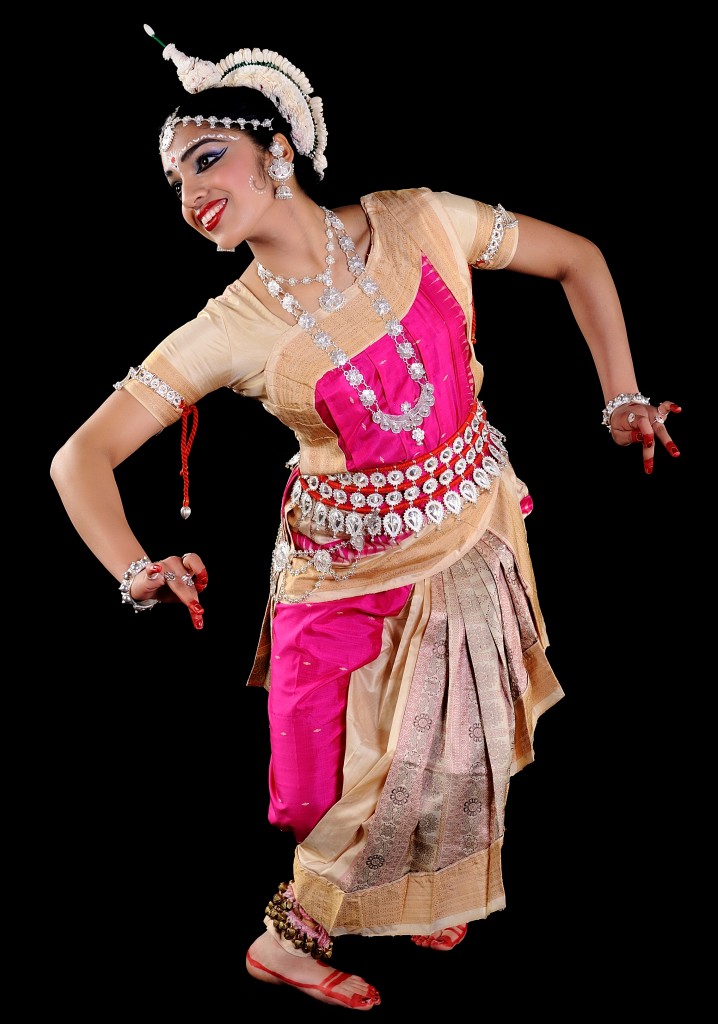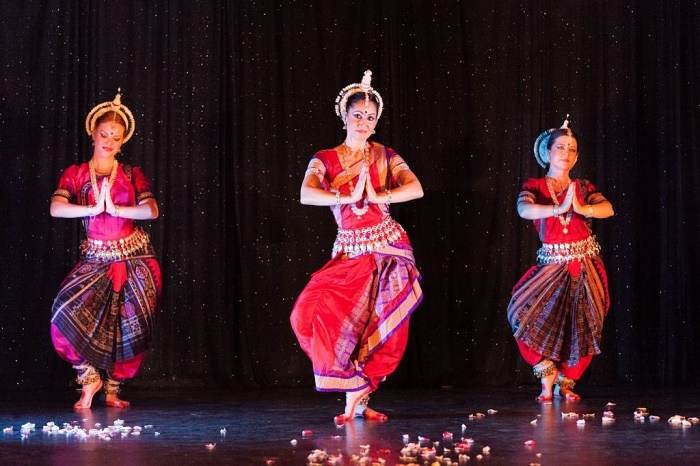- Home
- Indian Dances
- Odissi Dance
Odissi Dance -classical dance form from Odissa, India
Updated: 26-09-2022
Odissi Dance:
Quick Facts:
Country: India
State: Odisha
Foundations of Odissi: Found in Natya Shastra
Important Sites: Ranigumpha in Udayagiri, temples at Lalitgiri, Ratnagiri, Alatgiri
Odissi Dance is one of the major and important ancient Indian Classical dance form that originated in the temples of Odisha. It traces back its foundation to Natya Shastra. Earlier it was predominantly performed by women. The dance performance used to be on the religious stories which includes themes from Vaishnavisma and other Hindu Gods like Lord Shiva, Surya and also Hindu Goddess. The performance repertoire includes Nrita, nritya, natya and moksha
Odissi Dance: This dance form originated from the state of Odisha (formerly known as Orissa). Odissi was predominantly performed by women. In the modern era men have joined women in performing the Odissi dance. Like other dances even this dance is based on dance drama combination on mythological stories. The only difference between this dance form and other classical dances includes Tribhang posture which means it deals with head, bust and torso.
Odissi dance includes three elements Nritta (pure dance) Nritya (communicate the feelings) and Natya (team performance). Traditionally the dance begins with a prayer called as Mangalacharana. Usually in this a hymn is sung praising the God. After Mangalacharana flowers is offered to God which is called as Puspanjali, and later salutation is given to mother earth which is called as Bhumi Pranam.
The prayer offered also include their Gurus and to other dancers. While performing Nritta no song is sung. It is just slow hand movements along with neck, eyes, torso movements. Next comes the Nritya and later Natya part is done. The concluding part of the dance is called as Moksha.
History and sequences of Odissi dance
Like other dances even Odissi dance also traces its roots back to Natya Shastra, an ancient Hindu text on performing arts. Natya Shastra was written by Bharatha Muni which contains 6000 verses and 36 chapters.
The Dance form is divided into two forms in this text namely Nrita and Nritya. Nrita is pure dance and mainly deals with hand movements and gesture. While Nritya gives more importance on the expressions.
According to the Russian scholar, Natalia Lidova this text gives information on many theories of Indian Classical dances, postures, basic steps, Lord Shiva Tandava dance, rasa methods of acting
Natya Shastra refers to four major pravrittis (methods of expressive presentations) namely ' Odra- Magadhi', 'Avanti' and ' Dakshinanatya'. In this Odra refers to Odisha.

Some of the major historical evidence about the dance form are the inscriptions and carvings of the dance posture are found in Buddhists, Jain and Hindu archaeological sites. Some of the famous archaeological sites include Ranigumpha in Udaygiri, Ratnagiri and Aligiri sites.
The cave depicts various Odissi dance steps. Kapila Vatsyayana a famous and well-known scholar of Indian dance and architecture has mentioned in Jain manuscripts some famous dance poses of Odissi like Samapada and Tribhangi. It was discovered in Gujarat. The sculptures of Jagnath temple in Puri, Konark temple and Brahmeswara temple in Bhubaneswar show different poses of Odissi dance.
Odissi Dance during Medieval Era
Kapila Vatsyayan was an important Indian scholar of classical dance art and architecture. He mentions that the Kalpasutra is the manuscript of Jain text which has biographies of Jain Tirthankaras. It has discovered in Gujurat some of the Odissi dance poses like the Sampada, Chauka and Tribanga. This explains the popularity of the Odissi dance during the Medieval period.
Even the Hindu texts like 'Abhinaya Darpana' and 'Abhinaya Chandrika' provides a detail information on the hands, feet movements, standing postures and dance repertoires.
Similar postures of this dance were mentioned in the Hindu text on temple architecture Shilpaprakasha which deals with sculptures, Odia architecture and Odissi postures.
The famous Jaganath temple in Puri depicts Odissi dance. The Brahmeswara temple in Bhubaneswar and Sun temple at Konark are the other two important sites which showcase the sculptures of dancers and musicians.
The various compositions of poetic texts in 8th century by Shankaracharya and also Gita Govinda by 12th century focus on the modern Odissi.
Maharis who were the dancers performed in temples after gaining enough control on their art of dance.
During Mughal period
Mughals controlled most parts of Northern India. The Muslim armies ransacked and demolished the temples and monasteries of Odisha in eastern part of India.
This period of Mughals led to a negative development of all other Indian art forms. They curtailed the freedom of artists. During Tughlaq dynasty period, Firuz Shah Tughlaq invaded Odisha and demolished several temples including the Jagannath Temple in puri. He ruined the dancing statues and dance Halls
The pathetic part was the temple dancers were made to perform and entertain in sultan's court during the Mughal Era. They were forced to become concubines of the royals.
During British Rule
There were some friendly rulers as well who encouraged the various dance forms. During the British period discouraged the temple traditions and also many Christian missionaries made a staunch attack on the different Hindu temple dance arts. The missionaries launched the anti-dance movement in 1892 to ban all dance forms.
In 1910 the British government banned temple dancing this led to poverty of many dance artists due to no financial support.
Repertiore
The Odissi dance repertoire includes Nritta, Nritya and Natya. These three aspects are described in Natya Shastra, Abhinaya Chandrika and Abhinaya Darpana. The performance starts with Mangalacharana then followed by offering flowers called Pushpanjali to mother Earth.
Nritta which is a pure solo dance is fast and rhythmic dance. Here the viewer is given pure dance wherein the emphasis is on the motion, form, speed, range and pattern.
Nritya which is dance with emotions is slower and tries to communicate feelings through facial expressions, gestures body motion
The Natyam is a team performance unlike the other two which is solo performance. the dancer chooses to perform certain body movements to include the new character.
An Odissi dance performance is concluded by Mokshya that aims for the liberation of soul.
Some of the important talas in Odissi dance form include Ekatali, Khemata, Aditala, Srimana, kuduka, Jati tala and Tripata
The three main dance positions in Odissi are Samabhanga, Abhanga and Tribhanga. There are 63 Mudras in Odissi dance which include Asamyukta mudra, Samyukta mudra and Nrutya mudra. Some of the primary ragas in Odissi dance include Bhairavee, Baradi, Panchama and Karnatta. The instruments used are sitar, violin, cymbals and flute. The troupe usually consists of musicians, singers and musical instruments.
Costume worn by the dancers
The costume of this dance is similar to that of Bharatanatyam. The dancers wear bright coloured saree with lot of jewellery. The saree has pleats in front which gives beauty to saree as well it help in the foot movement for the dancers. Silver jewellery is worn on head, waist and ear. Waist band is worn which holds the saree.
Ghunguru is also worn by the dancers which makes rhythmic music when the dancers move their feet. Earrings called as Kapa beautify the ears and the sides of the head. The hands and wrists are covered with bangles. Along with bangles the dancers also wear Bahichudi on the upper arm. The arms are coloured with red colour dye called as Alta.
The male dancers wear Dhoti. The chest is bare or is covered with thin cloth.
Instruments and Music
This dance saw a decline during Islamic era of India and later was suppressed during British period. The revival of one of the finest classical dances started after independence.
This dance exists in two major forms one done by women usually done in temples and the other is performed by men dressed as women (gotipuas). This includes some athletic and acrobatic moves and is usually performed during festival seasons.
A major part of this dance form includes Indian ragas both from south and north India like Bhairavi, Kalyana, Dhanashree, Nata, Shree Gowda and Baradi. The music is usually Odissi music. Some of the instruments used are Mardala, Harmonium, Flute, Sitar, Violin and cymbals. The music is more lyrical than Carnatic and Hindustani.
Update on coronavirus in India
The dance form was present in three different schools called as
Maharis. This was performed by Oriya devadasi. It was more sensuous as compared to the other two.
Gotipuas. In this boy were dressed like girls
Nartaki. This dance took place in royal courts.
Some of the famous dancers in this form of dance include Raghunath Dutta, Deb Prasad Das, Anita Babu and many more.
Affiliate Disclosure:
If you make any purchase via a link on this site, I may receive a small commission with no added cost to you.












